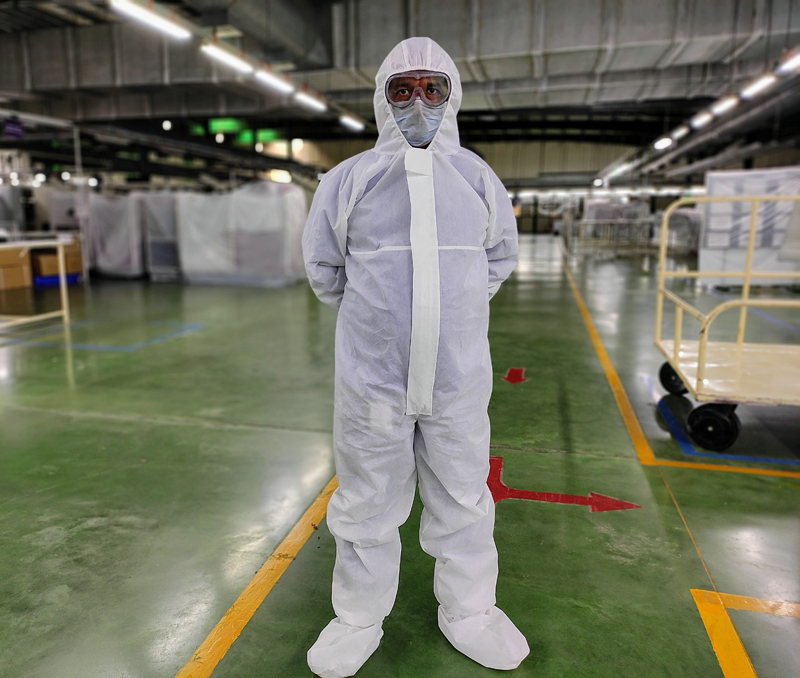The dangerous shortages of supplies for doctors and nurses fighting the COVID-19 pandemic has focused new attention on the need for more reusable protective medical garments. Part of the spectrum of Personal Protective Equipment or PPEs that support frontline care providers that are in high demand includes Isolation Barrier Gowns (ISO), surgical gowns, scrub suits, and cubicle curtains. PPE protects healthcare workers as they treat patients. Failure to have enough of these critical items available hinders patient and medical staff safety.
“An isolation gown is the first defence for healthcare providers, patients and visitors who spend time in a medical facility that faces the threat of emerging infectious diseases. These gowns control and protect against infectious hazards in a medical workplace. The gowns adhere to the Centers for Disease Control and Prevention (CDC) guidelines during patient care and procedures and are carefully examined and tracked during their lifetime” said Joe LaPorta, President & CEO, Healthcare Linen Services Group.
“Reusable PPE items can be sanitized and used between 80 to 100 times vs. only one time for a disposable item,” said David Potack, President of Unitex, a healthcare linen service which serves the hard-hit New York area.
“Due to the shortage of disposable items we have significantly accelerated the turn times to get reusable items back to the healthcare facilities we serve. Reusable PPE items that can be quickly hygienically cleaned, processed and put back in a hospital’s inventory are a force multiplier in a crisis and are changing how people think about reusable PPE invention now and in the future,” said Potack.
Reusable (i.e. washable) gowns are typically made of polyester or polyester-cotton fabrics and can be safely laundered and reused. “Our trucks are on the road daily and our laundries are working 24/7 to meet the needs of the healthcare facilities we serve. During a pandemic, such as the one we are now experiencing, the disposable market and supply chain are not guaranteed especially when one country makes most of the disposable items” said LaPorta.
“We have focused our development and production processes to help fight the battle against COVID-19. Many of our U.S. customers are now manufacturing personal protective equipment, and we’re right alongside them, supplying the medical-grade, protective textiles they need” said Halsey M. Cook, President and CEO, Milliken & Company.
Milliken is manufacturing these critical textiles in the U.S.A. This enables Milliken to utilize strong supply chain relationships to quickly deploy these fabrics to customers where they are made into final pieces of PPE.
Milliken’s BioSmart™ antimicrobial technology, for example, is used for scrubs, lab coats and hospital privacy curtains, harnessing the power of bleach to kill up to 99.9% of common bacteria on contact and making reusable items even safer and more effective.
“Medline is increasing its manufacturing capacity for reusable isolation gowns, patient gowns, and scrubs to help support the needs of healthcare providers,” said Jeremy Fogel, Vice President, Textiles Division at Medline. “Over the last several years, there has been a continued shift from reusable isolation gowns to disposable ones. Due to the current crisis, hospitals should consider implementing a more diversified supply chain strategy in the future by moving to a hybrid program that uses a combination of disposable and reusable isolation gowns.”
“Over the past few weeks we have seen a tremendous increase in our garment orders for medical caregivers because of this pandemic, not only on reusable isolation gowns, but on scrub apparel, reusable masks and other reusable garments as well,” said Dan Schwartz, vice president of Fashion Seal Healthcare.
“While I can’t speak for the disposable market outside of the massive supply shortage we have seen, we do anticipate a larger need for reusable garments in the future and will continue to support our laundry and distributor partners with their efforts,” said Schwartz.
“While we feel we were more prepared than most with ample inventory on hand, a situation like this teaches us that medical products can’t simply be treated as ‘just in time inventory.’ In the future, healthcare systems will need to work with their laundry partners and other suppliers to create inventory reserves that better satisfy their needs in an emergency,” added Schwartz.
“In the past it has sometimes been difficult to compete with disposable gowns,” said LaPorta. “Now our phones are ringing off the hook with healthcare facilities that are realizing that reusable gowns have a big advantage and should always be part of their supply chain as well as in emergency stockpiles.”
“Orders from current customers as well as new customers are asking that we help fill the void left by the shortage of disposable products with ISO gowns and cover gowns that are reusable,” said Liz Remillong, Vice President, Strategic Alliances, Crothall Laundry Services. “This crisis is changing the paradigm for the supply chain of the future as hospitals recognize the importance of being able to stock and reuse items that are critical to safety.”
“There is ample evidence that reusable medical textiles are better for the environment,” said Joseph Ricci, TRSA president & CEO. “The current pandemic and the sudden need for huge volumes of safety equipment is making the case that reusable items should be a major part of the nation’s stockpile and supply chain.”
